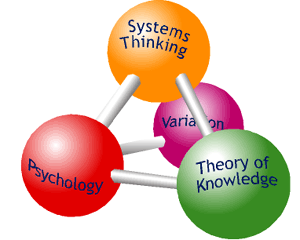An abridged excerpt from my new book, Getting Passion Out of Your Profession: How to keep loving your living come what may…
Strange is our situation here upon earth. Each of us comes for a short visit, not knowing why, yet sometimes seeming to a divine purpose. From the standpoint of daily life, however, there is one thing we do know: That we are here for the sake of others…for the countless unknown souls with whose fate we are connected by a bond of sympathy. Many times a day, I realize how much my outer and inner life is built upon the labors of people, both living and dead, and how earnestly I must exert myself in order to give in return as much as I have received.
Albert Einstein
Many years ago, a participant in one of my audiences, as he listened, sketched out illustrations and cartoon situations based on the themes of my presentation. At the end of the day he kindly presented me with his two favourites, one of which pretty much sums up the dog-eat-dog mentality of some workplaces. It shows four men in a rowboat, two in the bow, two in the stern. The boat is rapidly taking on water, and the two men at the rear of the boat are bailing frantically but to no avail. The rowboat is tipped up so that the two men in the bow are high and dry. The bubble caption hangs over the two in the bow, and reads, “We’re sure glad the hole isn’t at our end!”
They don’t get it. They don’t get that if the other end goes down, they do too! They don’t get that they’re, “all in the same boat”! They aren’t, as author Peter Senge (The Fifth Discipline: The Art & Practice of the Learning Organization”) would say, “Systems Thinking”.
Senge popularized the phrase and concept of “Systems Thinking” for a new generation, but management writers have been contributing to this concept for at least the past 60 years. The oldest volume on this subject in my own personal collection is, coincidentally, entitled Systems Thinking (Editor F. E. Emery) and was published in 1969, and that book references research on the subject dating to 1937!
At any rate, in The Fifth Discipline, Senge explains the concept of systems thinking. He points out that if a cloud masses, the sky darkens and leaves twist upwards, we know that it will rain. We also know that after the storm, the runoff will feed into the groundwater miles away, and the sky will grow clear by tomorrow. All these events are distant in time and space, and yet they are all part of the same pattern. Each has an influence on the rest, an influence that is usually hidden from view. To understand the rainstorm system, you need to contemplate the whole thing, not just individual parts of the pattern.
Business and other human endeavours are also systems. They, too, are bound by invisible fabrics of interrelated and connected actions that can take years to play out their effect on each other. Since we are part of the whole latticework ourselves, it’s hard to see the whole pattern of change. Instead, we tend to focus on snapshots of isolated parts of the system, and wonder why our deepest problems never seem to get solved.
That’s exactly what the rowboat picture shows…at least two of these four men are only focusing on a snapshot. And, because of their shortsightedness, all the sailors may be destined to go down, down, down! Each member of that boat could easily represent members of one work team. Alternatively, each man could represent a work team within a division, or four divisions at one location, or four different regional offices, or four companies in the same field. Are they all in the boat together or not? When it comes to your own team or workplace…are you all in your boat…together? Do you ever find yourself gloating that the “hole” isn’t at your end?
When we work hard to grow and nurture positive, productive workplace relationships, we care more about what happens to and with the “other guy”. The caring may spring from a growing sense of agape (selfless love or affection) towards our colleagues, or from a better understanding of the larger system at work; that what happens to others will also (immediately or eventually) happen to us. Regardless, committing to build positive relationships with colleagues and clients helps everyone reach their goals. Getting connected (or reconnected), and staying connected with those in your workplace circle of influence helps everyone bail out of “leaky” situations.
You’re More Connected Than You Think
Call it a clan, call it a network, call it a tribe, call it a family. Whatever you call it, whoever you are, you need one.
— Jane Howard
Nurturing and growing relationships is about recognizing relationship possibilities that are right under your nose, and fledgling relationships in which promise and potential exist. Everyone is more connected than they may first realize. I’ve heard it said that every person knows an average of 250 people. Imagine, if you know 250 people, and each of them know 250 people, you start to see how the concept of “six degrees of separation” may be true.
Everyone has at least a tale or two that shows what a small world it is that we live in. During one of my family-focused visits to England, we lunched in a grand old inn in Richmond, where our server asked if I was American. “No…an honest mistake…I’m Canadian”, I replied. She told me her chef was from Canada, and later brought her out to meet us.
I asked the cook where she was from, and, like me, she was from Toronto. I asked her what neighbourhood she lived in, to which she replied, “The Annex”. Well, so did I. It turned out that we lived on the same street 10 doors away from one another for the past ten years and never knew each other! What are the odds? Some might say the odds are pretty good when you consider the stereotypical anonymity of a big city; never-the-less, I went all the way to England, to a little town up the Thames River, only to discover a neighbour cooking my lunch!
We wouldn’t have even know this if we’d not acted and followed up on small-talk, curiosities, self-disclosed and listened for more information; these four techniques for engaging with another are key components of effective networking. Everyone has a personal tale or two to illustrate what a small world it is–what’re yours? You really are more connected than you think! Remember this especially when you feel alone, and think you don’t know anyone who can help you out.
Networking means opening up, self-disclosing, connecting, staying connected and/or reconnecting with people you admire, respect and value…and it’s just as valuable and important for colleagues within an organization to network with each other, as it is for entrepreneurs and the self-employed.
Here are five suggestions for elevating your networking effectiveness:
1. Work hard on a sincere and friendly tone of voice, especially on the phone. Practice by changing your voice mail daily; decide–before recording your greeting–how you’d like to come across to incoming callers. Then, before you save that greeting, play it back and listen to it to make sure it sounds the way you want. If it doesn’t…rub it out and start again, even if it takes a half-dozen tries. With practice, you’ll get it right almost every time out. When you’re not available, your message represents you. Ask yourself: Is my greeting representing me well, or does it provoke people to hang up without leaving a message? If you can’t assess this for yourself, ask someone (whose opinion you respect) to listen to your greeting and give you his or her impression. By the way…you’ll know you’ve got it “right” when you start getting compliments from callers who say they want to call you every day, just to hear your message and get a lift! Once you get that level of welcoming tone in your recorded greeting, I guarantee you’ll receive this kind of feedback. Try it! People want to stay in touch with you even more if they consider you a source of inspiration. It makes them want to do business with you. And it makes them proud to recommend you to others.
2. Ask lots of questions, in friendly conversation, of people you meet. Practice with neighbours over the backyard fence, with the person seated next to you on a flight and with colleagues, too. When you hear a point of concern or interest, if you have the resources and connections, help point the way ahead by offering to connect people with others you know (refer to point number 3, next, for more suggestions about this). Work hard at increasing your own comfort with sharing information.
3. Always, always, always ask permission of your friend, acquaintance, colleague or family member before referring a third person to your contact. Being the conduit for introductions shows good grace and etiquette.
4. Say thank-you, often and in a variety of ways. After I’ve helped connect two good people, I love the boost of getting a call or email that says, “Thanks…I appreciated your help!” Most of us like to know when we’ve helped others get what they want. If someone helps you, be sure to thank that individual for the part he/she played in helping you get what you wanted. If you get to the point where you call them multiple times with your thanks for many different kindnesses, boy, will they “get it” that they’re making a contribution! Let’s face it, sometimes we slug away, day-by-day, doing what we know is good work, without the kudos or reinforcement that confirm we’ve made a difference. Make sure you let people know they’ve made a difference for you.
5. Do What You Love…The Money Will Follow, so says the book of that title by Marsha Sinetar. It’s the same with networking. Sincerely love to network and the opportunities will naturally follow. Trust the process and see for yourself.
Let’s face it…it’s the end of September now–undeniably autumn. It’s back-to-school, back-to-work, back-to-meetings and back to a plethora of professional development opportunities, from organized association monthly chapter meetings and grand annual conferences, to neighbourhood or professionally focused networking groups. Make the most out of getting together. Get to know more people. You’ll be glad you did!
Knowledgeable people know facts. Successful and prosperous people know people.
— John Demartini
P.S. Feel free to join me at the Globe and Mail’s “Ask the Expert” on-line chatroom this Wednesday, September 27, 2006 at 1 p.m. EST at globeandmail.com.













